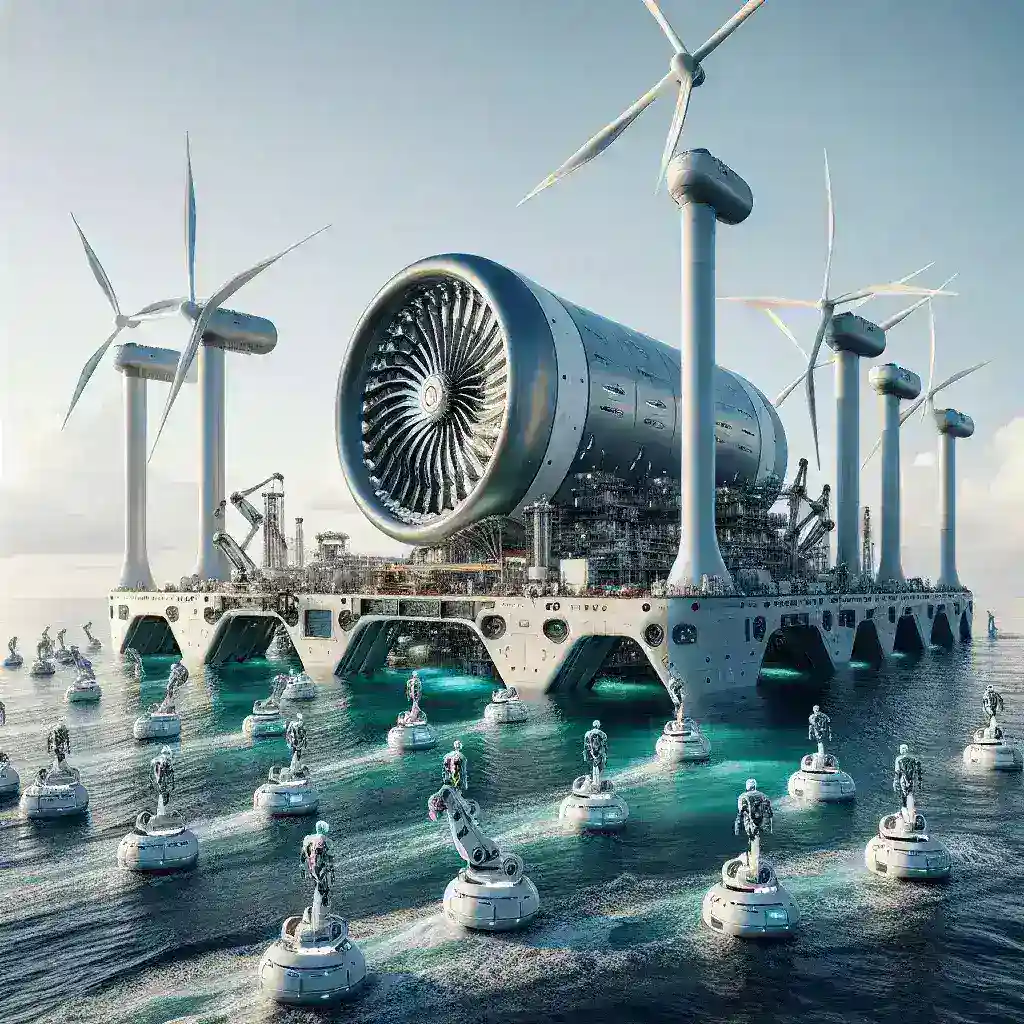Introduction
As the world grapples with the pressing need for sustainable energy sources, the development of ocean turbines has emerged as a beacon of hope. These innovative structures harness the untapped potential of ocean currents and waves, turning them into clean, renewable energy. The integration of AI robotics into the construction of these next-generation turbines marks a significant advancement, enabling the building process to occur with minimal human intervention. This article delves into the fascinating world of AI robotics and their role in revolutionizing ocean turbine construction.
The Evolution of Ocean Turbines
Ocean turbines, or marine turbines, have evolved significantly over the years. Initially, these structures were bulky and inefficient, relying heavily on human labor for installation and maintenance. However, as technology progressed, so did the design and functionality of these turbines. The introduction of AI robotics has played a pivotal role in this evolution, streamlining the entire process.
Historical Context
The concept of harnessing ocean energy dates back to the late 20th century. Early prototypes faced numerous challenges, including high operational costs and environmental impacts. However, with advancements in technology and a growing urgency to combat climate change, researchers began to explore smarter, more efficient ways to deploy these systems. AI robotics have emerged as a solution, offering improved precision and efficiency in turbine construction.
AI Robotics: The Game Changer
AI robotics represent the fusion of artificial intelligence and robotics, creating machines that can learn, adapt, and perform tasks autonomously. In the context of ocean turbine construction, these robots are designed to tackle various challenges, from assembly to maintenance.
Automation in Construction
The use of AI robotics in constructing ocean turbines minimizes the reliance on human workers, reducing labor costs and enhancing operational efficiency. Robots can perform repetitive tasks with high accuracy, ensuring that each component is assembled flawlessly. This not only speeds up the construction process but also minimizes the risk of human error.
Real-World Examples
- Autonomous Drones: Drones equipped with AI technology are being used to survey ocean sites efficiently. They can map out the seabed and identify the best locations for turbine installation, collecting data that would take humans much longer to gather.
- Robotic Arms: Advanced robotic arms are capable of assembling complex turbine components underwater, ensuring that they are securely fitted without the need for human divers.
Benefits of Minimal Human Intervention
Integrating AI robotics into ocean turbine construction offers several advantages:
- Safety: Reducing human involvement in potentially dangerous underwater environments enhances worker safety.
- Cost-effectiveness: Automation can significantly lower the costs associated with labor and operational delays.
- Speed: AI robotics can operate continuously, allowing for quicker project completion.
- Precision: AI systems provide unparalleled accuracy in measurements and assembly, leading to higher-quality turbines.
Future Predictions: The Next Decade
Looking ahead, the role of AI robotics in ocean turbine construction is expected to expand dramatically. With continued advancements in AI and machine learning, we can anticipate:
- Increased Autonomy: Future robots will operate with even less human oversight, using AI to make real-time decisions based on environmental variables.
- Enhanced Collaboration: AI systems will work in tandem with human engineers, providing support and insights that improve overall project outcomes.
- Global Expansion: As technology becomes more accessible, developing nations will also embrace AI robotics for their ocean turbine projects, leading to a global shift towards renewable energy.
Challenges and Considerations
While the benefits of AI robotics in ocean turbine construction are clear, several challenges must be addressed:
- Technical Limitations: Current robotics technology may struggle with complex tasks that require fine motor skills or decision-making in unpredictable environments.
- Environmental Concerns: The deployment of AI robotics must consider the potential impact on marine ecosystems, ensuring that the benefits outweigh any ecological risks.
- Regulatory Issues: The integration of robotics into the construction process necessitates updated regulations and safety standards to ensure compliance and protect workers and the environment.
Conclusion
The journey of AI robotics in building next-generation ocean turbines is just beginning. With minimal human intervention, these advanced machines promise to revolutionize the way we harness ocean energy, making it safer, faster, and more efficient. As we move forward, it is essential to balance technological advancement with environmental stewardship, ensuring a sustainable future for generations to come.
Expert Quotes
According to Dr. Emily Carter, a leading researcher in renewable energy technologies, “The integration of AI robotics in ocean turbine construction is not just a trend; it’s the future. We are witnessing an era where machines can operate independently to create innovations that will power our world sustainably.”
Final Thoughts
In summary, the collaboration between AI robotics and ocean turbine construction is paving the way for a cleaner, more sustainable energy future. As these technologies continue to evolve, the potential for innovation in renewable energy seems limitless.

